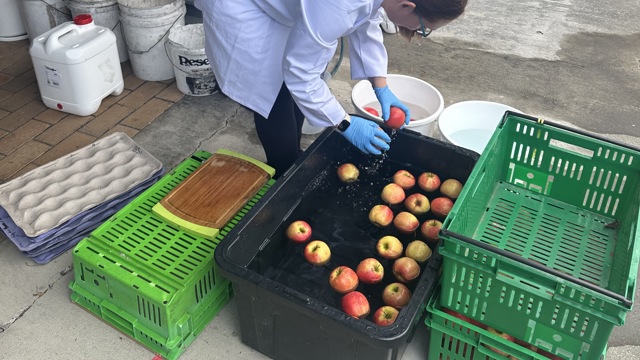What made you look into Hot Water Drench? What was it about this subject that interested you?
-
- In 2020, during Auckland's first lockdown, I was approached to act as the feet on the ground for a hot water treatment project on apples since Allan Woolf couldn’t be on-site. That opportunity allowed me to step into an ongoing research initiative focused on hot water treatments—and apparently, I did well enough to stick around. Since then, I’ve been involved in hot water research. I’m passionate about tackling the issue of postharvest loss—more than a third of what growers produce never reaches consumers. I’m especially interested in technologies that reduce rots, prevent disorders, and help keep perfectly good food out of landfill. As we engaged with potential users, our work evolved from hot water immersion to hot water drenching, adapting the approach to better meet practical needs. After all, even the best ideas are meaningless unless they can be applied in the real world.
What was something surprising about the research that you discovered?
-
- I was amazed how well fungicides work in limiting rots on our fruit, and keeping spore counts low in the orchards. Even growers who cannot spray fungicides benefit from a form of “herd immunity”, similar to how vaccines work. It’s a great concern for us how rot incidences could increase if fungicide use gets restricted. The herd immunity in our orchards makes it difficult for us to prove how well hot water treatments work – the decreases in rot incidences after hot water treatments do not look impressive when they are already low in the control fruit. I am so grateful that our partners in this project (NZAPI, the growers, packhouses and exporters) understand how important it is to have alternative control strategies ready for the future.
What was something challenging that you encountered during the research?
-
- Throughout the years that we have developed hot water projects; we used direct feedback from packhouse managers and staff. We had to reconsider options based on limitations in the packhouses and think about how to speed up the treatments without damaging fruit or losing too much efficacy of the treatments. I enjoy working with industry partners, and I love seeing my recommendations being used in the real world. A project like this needs a lot of communication, compromise, and collaboration. After that, we can figure out how to make the science fit. It’s completely the opposite of how we usually do research.
When did you start working at PFR?
-
- I started working for PFR in December 2016. Before that I worked for the University of Johannesburg as a lecturer in Plant Biotechnology and Microbiology for over a decade. During my postdoctoral research, I investigated the antibacterial properties of traditional medicinal plants from South Africa. But my first passion has always been postharvest science, my PhD project was on the storage of cherry tomatoes, and my MSc was to study the membrane integrity of carnation flowers during their vase life.
Have you always been interested in plant/produce research?
-
- Even as a child, I loved learning about plants. It fascinated me that plants can provide shelter, clothing, food, and medicine. One of my professors used to say that photosynthesis is the most important chemical reaction on earth. We have figured out so many ways to make use of that reaction, and we still have so much to learn.
What’s been the most interesting piece of research you’ve completed at PFR?
-
- Oh, this is a tough question! Each project has so much merit and is important in its own way. One of my most intimidating projects was in 2019 when I had to plan and coordinate Harvista spray trials on multiple blocks in Hawke’s Bay and Tasman District before it was registered for use in New Zealand. It was a crop-destruct trial and could have been very costly if anything went wrong. I went through a huge learning curve, moving from a postharvest lab to managing spray trials in orchards! Then we had field days while the apples were still on the trees, and we had to prepare information sheets on fruit maturation and postharvest storage performance to act as supporting documents to get Harvista registered for use in New Zealand. My prettiest project was a storage trial with peonies (lots of falling petals). And the tastiest one? Every single apple storage trial!



